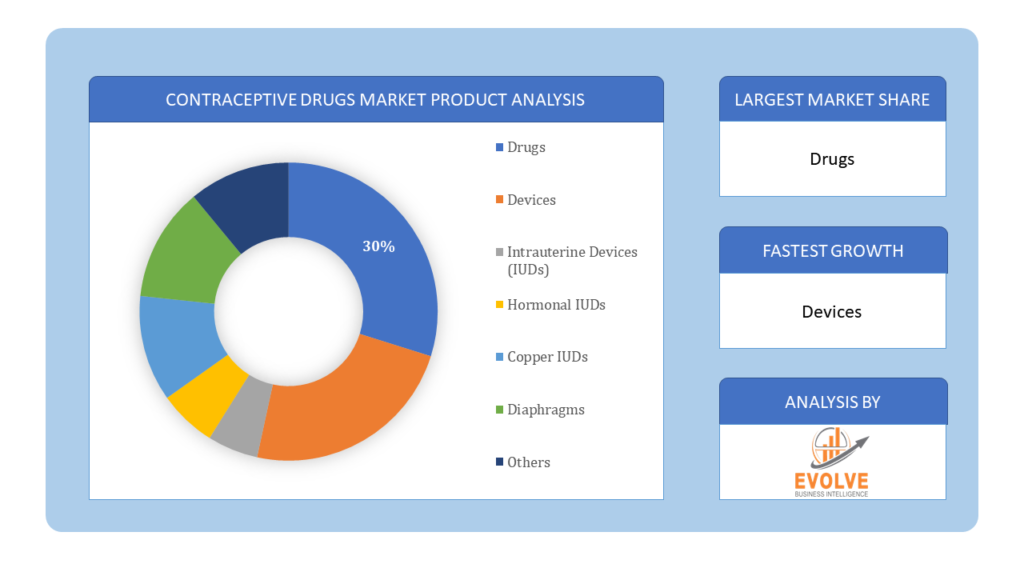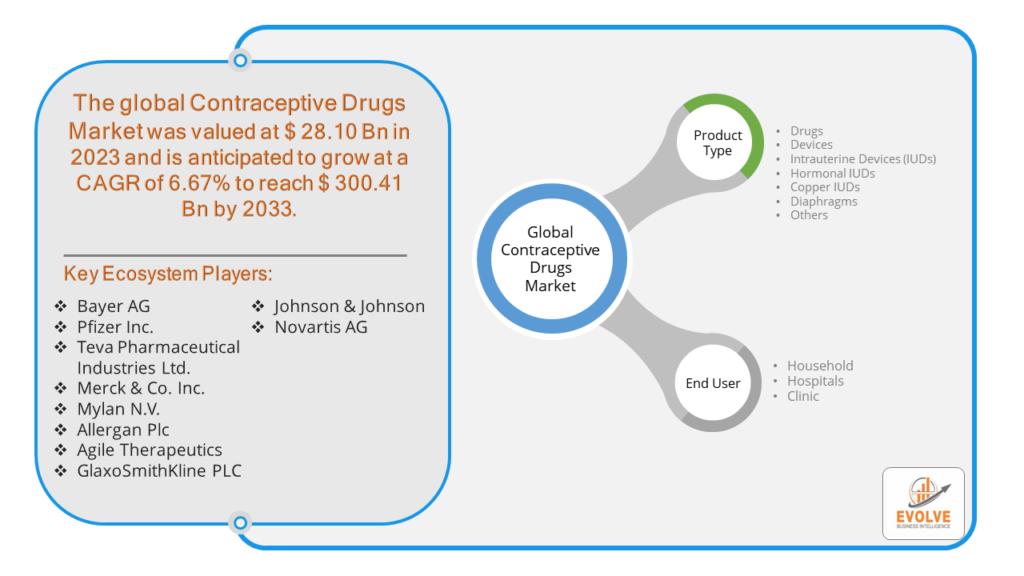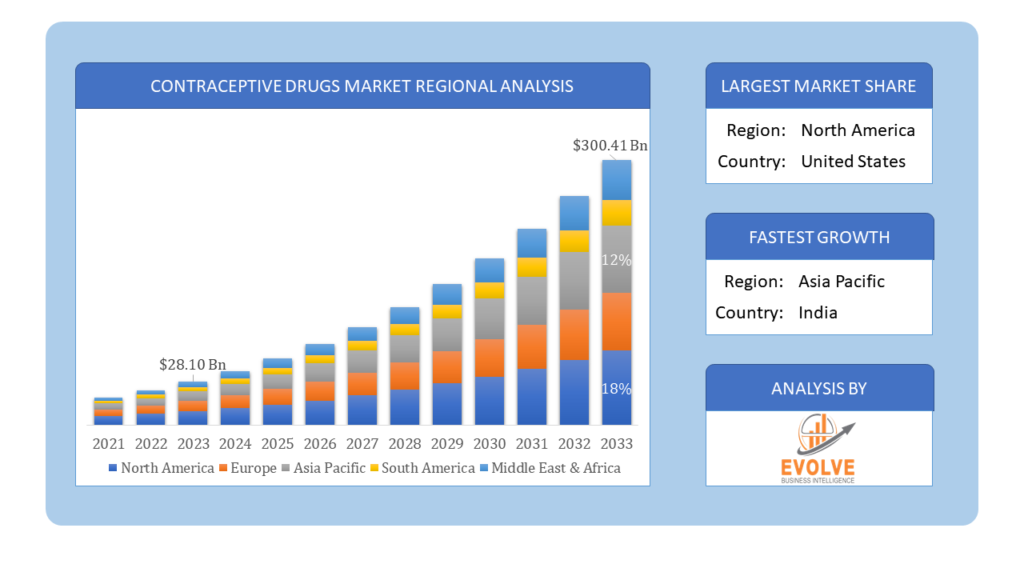Contraceptive Drugs Market Analysis and Global Forecast 2023-2033
$ 1,390.00 – $ 5,520.00Price range: $ 1,390.00 through $ 5,520.00
Contraceptive Drugs Market Research Report: Information By Product Type (Drugs, Devices, Intrauterine Devices (IUDs), Hormonal IUDs, Copper IUDs, Diaphragms, Others), By End Users (Household, Hospitals, Clinic), and by Region — Forecast till 2033
Page: 162
Contraceptive Drugs Market Overview
The Contraceptive Drugs Market Size is expected to reach USD 300.41 Billion by 2033. The Contraceptive Drugs Market industry size accounted for USD 28.10 Billion in 2023 and is expected to expand at a compound annual growth rate (CAGR) of 6.67% from 2023 to 2033. The contraceptive drugs market is the global market for medications used to prevent pregnancy. This includes oral contraceptives (birth control pills), injectables, skin patches, and vaginal rings. These medications work in a variety of ways, such as by preventing ovulation (the release of an egg from the ovary), thickening cervical mucus to make it more difficult for sperm to reach the egg, or suppressing the lining of the uterus to prevent implantation of a fertilized egg.
The market is driven by factors such as rising awareness about reproductive health, government initiatives, and the need to prevent unintended pregnancies, while also facing challenges like cultural resistance and side effects associated with some contraceptive methods. The contraceptive drugs market is a large and growing market, driven by a number of factors like Increasing awareness of the benefits of family planning and Rising demand for convenient and effective birth control methods.
Global Contraceptive Drugs Market Synopsis
The COVID-19 pandemic had significant impacts on the Contraceptive Drugs Market. Lockdowns and restrictions led to the temporary shutdown of manufacturing facilities, causing production delays. Restrictions on transportation and logistics affected the distribution of contraceptive drugs, leading to shortages in some regions. Many family planning services were suspended or scaled back, reducing access to contraceptive counseling and products. The pandemic accelerated the adoption of telehealth services, providing a new avenue for accessing contraceptive consultations and prescriptions. The pandemic highlighted the importance of maintaining access to sexual and reproductive health services during health crises. Online pharmacies gained popularity as a safer and more convenient option for purchasing contraceptives during the pandemic.
Contraceptive Drugs Market Dynamics
The major factors that have impacted the growth of Contraceptive Drugs Market are as follows:
Drivers:
Ø Increasing Awareness and Education
Enhanced education and awareness about sexual health, reproductive rights, and family planning have increased the adoption of contraceptive methods. Development of new and improved contraceptive drugs and delivery methods, such as long-acting reversible contraceptives (LARCs) and non-hormonal options. Ongoing R&D efforts to enhance the efficacy, safety, and convenience of contraceptive products. Increasing rates of unintended pregnancies drive the demand for effective contraceptive methods. Urbanization and lifestyle changes contribute to the need for better family planning solutions.
Restraint:
- Perception of Side Effects and Health Concerns
Potential side effects associated with hormonal contraceptives, such as weight gain, mood changes, and increased risk of blood clots, can deter usage. Concerns about long-term health risks, including cancer and cardiovascular issues, associated with certain contraceptives. Inadequate healthcare infrastructure and limited availability of contraceptives in rural and underserved regions. High costs of certain contraceptive methods, particularly newer or branded products, can be a barrier for many individuals, especially in low-income countries. Lack of comprehensive sexual and reproductive health education in some regions leads to low awareness and understanding of contraceptive options.
Opportunity:
⮚ Growing demand for Public Health Campaigns and Education
Initiatives to increase awareness about the benefits of contraceptives and dispel myths and misconceptions. Integration of comprehensive sexual and reproductive health education in school curricula and community programs to inform and empower individuals about contraceptive options. Rising popularity and demand for LARCs, such as intrauterine devices (IUDs) and implants, due to their effectiveness and convenience. Providing training for healthcare providers to increase their proficiency in administering LARCs and educating patients about their benefits. Development of sustainable and eco-friendly contraceptive products that appeal to environmentally conscious consumers.
Contraceptive Drugs Market Segment Overview
By Product
 Based on Product, the market is segmented based on Drugs, Devices, Intrauterine Devices (IUDs), Hormonal IUDs, Copper IUDs, Diaphragms and Others. The Drugs segment dominant the market. This is owing to the clinical advantages of oral contraceptive drugs over other traditional techniques, as well as the reduced cost of these medications compared to other modern contraceptive drugs options.
Based on Product, the market is segmented based on Drugs, Devices, Intrauterine Devices (IUDs), Hormonal IUDs, Copper IUDs, Diaphragms and Others. The Drugs segment dominant the market. This is owing to the clinical advantages of oral contraceptive drugs over other traditional techniques, as well as the reduced cost of these medications compared to other modern contraceptive drugs options.
By End User
Based on End Users, the market segment has been divided into the Household, Hospitals and Clinic. The Household segment dominant the market. Higher income households have better access to a variety of contraceptive options and are more likely to use modern contraceptives. Cultural attitudes towards family planning and contraceptive use vary significantly and can impact household decisions.
Global Contraceptive Drugs Market Regional Analysis
Based on region, the global Contraceptive Drugs Market has been divided into North America, Europe, Asia-Pacific, the Middle East & Africa, and Latin America. North America is projected to dominate the use of the Contraceptive Drugs Market followed by the Asia-Pacific and Europe regions.
 Contraceptive Drugs North America Market
Contraceptive Drugs North America Market
North America holds a dominant position in the Contraceptive Drugs Market. North America region currently holds the largest market share, driven by factors like high awareness about birth control methods, established healthcare infrastructure, and a large population of women in their childbearing years. High awareness and acceptance of contraceptive methods. Well-established healthcare infrastructure and insurance coverage for contraceptives.
Contraceptive Drugs Asia-Pacific Market
The Asia-Pacific region has indeed emerged as the fastest-growing market for the Contraceptive Drugs Market industry. This is due to factors like rising disposable incomes, increasing urbanization, and growing awareness about family planning. Countries like China and India are expected to be major contributors to this growth. Expand access to rural and underserved populations. Increase investment in awareness campaigns and education programs.
Competitive Landscape
The global Contraceptive Drugs Market is highly competitive, with numerous players offering a wide range of software solutions. The competitive landscape is characterized by the presence of established companies, as well as emerging startups and niche players. To increase their market position and attract a wide consumer base, the businesses are employing various strategies, such as product launches, and strategic alliances.
Prominent Players:
- Bayer AG
- Pfizer Inc.
- Teva Pharmaceutical Industries Ltd.
- Merck & Co. Inc.
- Mylan N.V.
- Allergan Plc
- Agile Therapeutics
- GlaxoSmithKline PLC
- Johnson & Johnson
- Novartis AG
Scope of the Report
Global Contraceptive Drugs Market, by Product Type
- Drugs
- Devices
- Intrauterine Devices (IUDs)
- Hormonal IUDs
- Copper IUDs
- Diaphragms
- Others
Global Contraceptive Drugs Market, by End User
- Household
- Hospitals
- Clinic
Global Contraceptive Drugs Market, by Region
- North America
- US
- Canada
- Mexico
- Europe
- UK
- Germany
- France
- Italy
- Spain
- Benelux
- Nordic
- Rest of Europe
- Asia Pacific
- China
- Japan
- South Korea
- Indonesia
- Austalia
- Malaysia
- India
- Rest of Asia Pacific
- South America
- Brazil
- Argentina
- Rest of South America
- Middle East & Africa
- Saudi Arabia
- UAE
- Egypt
- South Africa
- Rest of Middle East & Africa
| Parameters | Indicators |
|---|---|
| Market Size | 2033: $300.41 Billion |
| CAGR | 6.67% CAGR (2023-2033) |
| Base year | 2022 |
| Forecast Period | 2023-2033 |
| Historical Data | 2021 |
| Report Coverage | Revenue Forecast, Competitive Landscape, Growth Factors, and Trends |
| Key Segmentations | Product Type, End User |
| Geographies Covered | North America, Europe, Asia-Pacific, Latin America, Middle East, Africa |
| Key Vendors | Bayer AG, Pfizer Inc., Teva Pharmaceutical Industries Ltd., Merck & Co. Inc., Mylan N.V., Allergan Plc, Agile Therapeutics, GlaxoSmithKline PLC, Johnson & Johnson and Novartis AG |
| Key Market Opportunities | • The growing demand for Public Health Campaigns and Education • Focus on Long-Acting Reversible Contraceptives (LARCs) |
| Key Market Drivers | • Increasing Awareness and Education • Technological Advancements |
REPORT CONTENT BRIEF:
- High-level analysis of the current and future Contraceptive Drugs Market trends and opportunities
- Detailed analysis of current market drivers, restraining factors, and opportunities in the future
- Contraceptive Drugs Market historical market size for the year 2021, and forecast from 2023 to 2033
- Contraceptive Drugs Market share analysis at each product level
- Competitor analysis with detailed insight into its product segment, Government & Defense strength, and strategies adopted.
- Identifies key strategies adopted including product launches and developments, mergers and acquisitions, joint ventures, collaborations, and partnerships as well as funding taken and investment done, among others.
- To identify and understand the various factors involved in the global Contraceptive Drugs Market affected by the pandemic
- To provide a detailed insight into the major companies operating in the market. The profiling will include the Government & Defense health of the company’s past 2-3 years with segmental and regional revenue breakup, product offering, recent developments, SWOT analysis, and key strategies.
Press Release

Global Pharmaceutical Manufacturing Market to Reach $1.38 Trillion by 2035 with 7.35% CAGR, New Research Shows

The Global Mammography Market Is Estimated To Record a CAGR of Around 10.29% During The Forecast Period

Glue Stick Market to Reach USD 2.35 Billion by 2034

Podiatry Service Market to Reach USD 11.88 Billion by 2034

Microfluidics Technology Market to Reach USD 32.58 Billion by 2034

Ferric Chloride Market to Reach USD 10.65 Billion by 2034

Family Practice EMR Software Market to Reach USD 21.52 Billion by 2034

Electric Hairbrush Market to Reach USD 15.95 Billion by 2034

Daily Bamboo Products Market to Reach USD 143.52 Billion by 2034

Cross-border E-commerce Logistics Market to Reach USD 112.65 Billion by 2034
Frequently Asked Questions (FAQ)
What is the study period of the Contraceptive Drugs Market?
The study period for the Contraceptive Drugs Market is from 2023 to 2033.
What is the growth rate of the Contraceptive Drugs Market?
The Contraceptive Drugs Market is expected to expand at a compound annual growth rate (CAGR) of 6.67% from 2023 to 2033.
Which region has the highest growth rate in the Contraceptive Drugs Market?
The Asia-Pacific region has the highest growth rate in the Contraceptive Drugs Market, driven by rising disposable incomes and increasing awareness about family planning.
Which region has the largest share of the Contraceptive Drugs Market?
North America holds the largest share of the global Contraceptive Drugs Market due to high awareness and established healthcare infrastructure.
Who are the key players in the Contraceptive Drugs Market?
Key players in the Contraceptive Drugs Market include Bayer AG, Pfizer Inc., Teva Pharmaceutical Industries Ltd., Merck & Co. Inc., Mylan N.V., Allergan Plc, Agile Therapeutics, GlaxoSmithKline PLC, Johnson & Johnson, and Novartis AG.
Do you offer Post sales support?
Yes, we offer 16 hours of analyst support to solve the queries
Do you sell particular sections of a report?
Yes, we provide regional as well as country-level reports. Other than this we also provide a sectional report. Please get in contact with our sales representatives.
Table of Content
Chapter 1. Executive Summary Chapter 2. Scope Of The Study 2.1. Market Definition 2.2. Scope Of The Study 2.2.1. Objectives of Report 2.2.2. Limitations 2.3. Market Structure Chapter 3. Evolve BI Methodology Chapter 4. Market Insights and Trends 4.1. Supply/ Value Chain Analysis 4.1.1. Raw End Users Providers 4.1.2. Manufacturing Process 4.1.3. Distributors/Retailers 4.1.4. End-Use Industry 4.2. Porter’s Five Forces Analysis 4.2.1. Threat Of New Entrants 4.2.2. Bargaining Power Of Buyers 4.2.3. Bargaining Power Of Suppliers 4.2.4. Threat Of Substitutes 4.2.5. Industry Rivalry 4.3. Impact Of COVID-19 on the Contraceptive Drugs Market 4.3.1. Impact on Market Size 4.3.2. End-Use Industry Trend, Preferences, and Budget Impact 4.3.3. Regulatory Framework/Government Policies 4.3.4. Key Players' Strategy to Tackle Negative Impact 4.3.5. Opportunity Window 4.4. Technology Overview 12.28. Macro factor 4.6. Micro Factor 4.7. Demand Supply Gap Analysis of the Contraceptive Drugs Market 4.8. Import Analysis of the Contraceptive Drugs Market 4.9. Export Analysis of the Contraceptive Drugs Market Chapter 5. Market Dynamics 5.1. Introduction 5.2. DROC Analysis 5.2.1. Drivers 5.2.2. Restraints 5.2.3. Opportunities 5.2.4. Challenges 5.3. Patent Analysis 5.4. Industry Roadmap 5.5. Parent/Peer Market Analysis Chapter 6. Global Contraceptive Drugs Market, By Product Type 6.1. Introduction 6.2. Drugs 6.3. Devices 6.4. Intrauterine Devices (IUDs) 6.5. Hormonal IUDs 6.6. Copper IUDs 6.7. Diaphragms 6.8. Others Chapter 7. Global Contraceptive Drugs Market, By End User 7.1. Introduction 7.2. Household 7.3. Hospitals 7.4. Clinic Chapter 8. Global Contraceptive Drugs Market, By Region 8.1. Introduction 8.2. North America 8.2.1. Introduction 8.2.2. Driving Factors, Opportunity Analyzed, and Key Trends 8.2.3. Market Size and Forecast, By Country, 2023-2033 8.2.4. Market Size and Forecast, By Product Type, 2023-2033 8.2.5. Market Size and Forecast, By End User, 2023-2033 8.2.6. US 8.2.6.1. Introduction 8.2.6.2. Driving Factors, Opportunity Analyzed, and Key Trends 8.2.6.3. Market Size and Forecast, By Product Type, 2023-2033 8.2.6.4. Market Size and Forecast, By End User, 2023-2033 8.2.7. Canada 8.2.7.1. Introduction 8.2.7.2. Driving Factors, Opportunity Analyzed, and Key Trends 8.2.7.4. Market Size and Forecast, By Product Type, 2023-2033 8.2.7.5. Market Size and Forecast, By End User, 2023-2033 8.3. Europe 8.3.1. Introduction 8.3.2. Driving Factors, Opportunity Analyzed, and Key Trends 8.3.3. Market Size and Forecast, By Country, 2023-2033 8.3.4. Market Size and Forecast, By Product Type, 2023-2033 8.3.5. Market Size and Forecast, By End User, 2023-2033 8.3.6. Germany 8.3.6.1. Introduction 8.3.6.2. Driving Factors, Opportunity Analyzed, and Key Trends 8.3.6.3. Market Size and Forecast, By Product Type, 2023-2033 8.3.6.4. Market Size and Forecast, By End User, 2023-2033 8.3.7. France 8.3.7.1. Introduction 8.3.7.2. Driving Factors, Opportunity Analyzed, and Key Trends 8.3.7.3. Market Size and Forecast, By Product Type, 2023-2033 8.3.7.4. Market Size and Forecast, By End User, 2023-2033 8.3.8. UK 8.3.8.1. Introduction 8.3.8.2. Driving Factors, Opportunity Analyzed, and Key Trends 8.3.8.3. Market Size and Forecast, By Product Type, 2023-2033 8.3.8.4. Market Size and Forecast, By End User, 2023-2033 8.3.9. Italy 8.3.9.1. Introduction 8.3.9.2. Driving Factors, Opportunity Analyzed, and Key Trends 8.3.9.3. Market Size and Forecast, By Product Type, 2023-2033 8.3.9.4. Market Size and Forecast, By End User, 2023-2033 8.3.11. Rest Of Europe 8.3.11.1. Introduction 8.3.11.2. Driving Factors, Opportunity Analyzed, and Key Trends 8.3.11.3. Market Size and Forecast, By Product Type, 2023-2033 8.3.11.4. Market Size and Forecast, By End User, 2023-2033 8.4. Asia-Pacific 8.4.1. Introduction 8.4.2. Driving Factors, Opportunity Analyzed, and Key Trends 8.4.3. Market Size and Forecast, By Country, 2023-2033 8.4.4. Market Size and Forecast, By Product Type, 2023-2033 8.12.28. Market Size and Forecast, By End User, 2023-2033 8.4.6. China 8.4.6.1. Introduction 8.4.6.2. Driving Factors, Opportunity Analyzed, and Key Trends 8.4.6.3. Market Size and Forecast, By Product Type, 2023-2033 8.4.6.4. Market Size and Forecast, By End User, 2023-2033 8.4.7. India 8.4.7.1. Introduction 8.4.7.2. Driving Factors, Opportunity Analyzed, and Key Trends 8.4.7.3. Market Size and Forecast, By Product Type, 2023-2033 8.4.7.4. Market Size and Forecast, By End User, 2023-2033 8.4.8. Japan 8.4.8.1. Introduction 8.4.8.2. Driving Factors, Opportunity Analyzed, and Key Trends 8.4.8.3. Market Size and Forecast, By Product Type, 2023-2033 8.4.8.4. Market Size and Forecast, By End User, 2023-2033 8.4.9. South Korea 8.4.9.1. Introduction 8.4.9.2. Driving Factors, Opportunity Analyzed, and Key Trends 8.4.9.3. Market Size and Forecast, By Product Type, 2023-2033 8.4.9.4. Market Size and Forecast, By End User, 2023-2033 8.4.10. Rest Of Asia-Pacific 8.4.10.1. Introduction 8.4.10.2. Driving Factors, Opportunity Analyzed, and Key Trends 8.4.10.3. Market Size and Forecast, By Product Type, 2023-2033 8.4.10.4. Market Size and Forecast, By End User, 2023-2033 8.5. Rest Of The World (RoW) 8.5.1. Introduction 8.5.2. Driving Factors, Opportunity Analyzed, and Key Trends 8.5.3. Market Size and Forecast, By Product Type, 2023-2033 8.5.4. Market Size and Forecast, By End User, 2023-2033 Chapter 9. Company Landscape 9.1. Introduction 9.2. Vendor Share Analysis 9.3. Key Development Analysis 9.4. Competitor Dashboard Chapter 10. Company Profiles 10.1. Bayer AG 10.1.1. Business Overview 10.1.2. Government & Defense Analysis 10.1.2.1. Government & Defense – Existing/Funding 10.1.3. Product Portfolio 10.1.4. Recent Development and Strategies Adopted 10.1.5. SWOT Analysis 10.2. Pfizer Inc. 10.2.1. Business Overview 10.2.2. Government & Defense Analysis 10.2.2.1. Government & Defense – Existing/Funding 10.2.3. Product Portfolio 10.2.4. Recent Development and Strategies Adopted 10.2.5. SWOT Analysis 10.3. Teva Pharmaceutical Industries Ltd. 10.3.1. Business Overview 10.3.2. Government & Defense Analysis 10.3.2.1. Government & Defense – Existing/Funding 10.3.3. Product Portfolio 10.3.4. Recent Development and Strategies Adopted 10.3.5. SWOT Analysis 10.4. Merck & Co. Inc. 10.4.1. Business Overview 10.4.2. Government & Defense Analysis 10.4.2.1. Government & Defense – Existing/Funding 10.4.3. Product Portfolio 10.4.4. Recent Development and Strategies Adopted 10.12.28. SWOT Analysis 10.5. Mylan N.V. 10.5.1. Business Overview 10.5.2. Government & Defense Analysis 10.5.2.1. Government & Defense – Existing/Funding 10.5.3. Product Portfolio 10.5.4. Recent Development and Strategies Adopted 10.5.5. SWOT Analysis 10.6. Allergan Plc 10.6.1. Business Overview 10.6.2. Government & Defense Analysis 10.6.2.1. Government & Defense – Existing/Funding 10.6.3. Product Portfolio 10.6.4. Recent Development and Strategies Adopted 10.6.5. SWOT Analysis 10.7. Agile Therapeutics 10.7.1. Business Overview 10.7.2. Government & Defense Analysis 10.7.2.1. Government & Defense – Existing/Funding 10.7.3. Product Portfolio 10.7.4. Recent Development and Strategies Adopted 10.7.5. SWOT Analysis 10.8 GlaxoSmithKline PLC 10.8.1. Business Overview 10.8.2. Government & Defense Analysis 10.8.2.1. Government & Defense – Existing/Funding 10.8.3. Product Portfolio 10.8.4. Recent Development and Strategies Adopted 10.8.5. SWOT Analysis 10.9 Johnson & Johnson 10.9.1. Business Overview 10.9.2. Government & Defense Analysis 10.9.2.1. Government & Defense – Existing/Funding 10.9.3. Product Portfolio 10.9.4. Recent Development and Strategies Adopted 10.9.5. SWOT Analysis 10.10. Novartis AG 10.10.1. Business Overview 10.10.2. Government & Defense Analysis 10.10.2.1. Government & Defense – Existing/Funding 10.10.3. Product Portfolio 10.10.4. Recent Development and Strategies Adopted 10.10.5. SWOT Analysis
Connect to Analyst
Research Methodology







